| |

Home
|
|
|
|
Cooperative Planning and Student Growth
“The task of the Secondary School Study was to find means by which the curricular offerings of black high schools could be influenced by accepted educational practices that had enriched other school curricula but which were practically unknown in most black schools.” W. H. Brown & W. A. Robinson, Serving Negro Schools (1946)
“While the school was a place of great discipline,
it was also a wonderful place—we so enjoyed being there.
The curriculum was vast and prepared us for life.”
Saltine Austin Tyler

1944 Magnolia Avenue students
(including Carrie Reynolds who appears
in the middle of the photograph, 2nd row, third from the left)
from Secondary School Study documents:
Cooperative Planning at Magnolia Avenue High School
"The Magnolia teachers believe that cooperative planning among teachers working in the same subject area is essential. We offer several examples which seem to indicate the extent to which this belief affects our planning activities.
In the social studies there has been but one instance of formal cooperative planning among the three teachers in this department. However, throughout the year, these teachers have discussed their classroom plans informally. Frequently, they have exchanged ideas, suggestions and criticisms. The instance of formal planning was an attempt to organize a departmental unit on consumer education. Certain basic steps in planning the unit were taken and problems, objectives, activities and materials were considered. The teachers decided which phases of the unit each would attempt to develop in the different classes. They make an effort to prevent unnecessary overlapping in classroom experiences.
The two home economics teachers get together often for the purpose of planning teaching units. They feel that joint planning results in richer experiences for their pupils and eliminates unnecessary repetition. In a unit on Child Care and Development, one teacher planned learning experiences dealing with nutrition and clothing of the mother and child. The other teachers planned experiences which lead to an understanding of the growth and development of the preschool child.
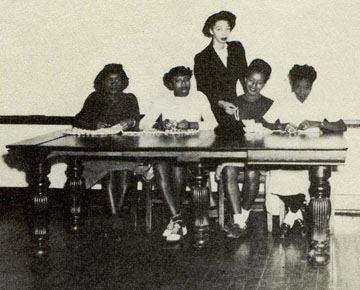
This year the faculty has attempted to become acquainted with the possibilities and advantages of teacher-teacher planning and teacher-pupil planning on departmental and school-wide bases. Plans are underway in the general faculty sessions for a more complete exploration of this technique during next year."
from the Secondary School Study Catalog, circa 1940 |
|
|
|
|
|
|
|
|
|
|
|
|
|
|
|
|
|
|
|
|
|
|
|
|
|
|
“Homeroom was a special time when we could talk to one another about our thoughts and feelings. Everyone could speak what was on their minds. It brought us together each day. We learned things about ourselves that carried us on throughout our life. Having that time together—a shared experience—was so special and meaningful.”
Frances Pearline Williams
|

Frances Pearline Williams
|
|
|
|
|
|
|
|
|
|
from Secondary School Study documents:
Activities at Magnolia Avenue High School
"The faculty of our school, after a series of meeting, has organized for the purpose of formulating plans for a cooperative enterprise in the interests of our boys and girls. We shall attempt to concentrate particularly on our system of evaluation, with the view of improving it. The various areas will contribute to the cooperative enterprise as follows:
The entire faculty will decide what it is trying to have the child achieve in the form of skills, habits, attitudes, etc.: then each faculty member will ascertain how this particular work can and will contribute to these general school goals and direct his activities accordingly.
We plan to discover the extent to which these goals have been realized by experimenting with check sheets, etc. that we deem suitable for our situation.
We will need materials, suggestions, and visits from staff members. We will request those as the study progresses.
Mr. Buck and his class in Negro history are studying minority groups and are reporting progress of their study in our weekly assemblies. A Jewish rabbi appeared before the class and discussed the problems of his group. They attempted to get a native of China to do the same.
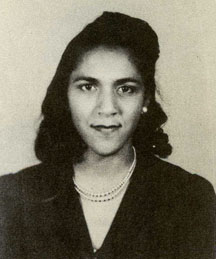
Mayme W. Smith
Two of Miss Smith’s classes have been photographing as a project, and they are very greatly interested in what they are doing." To and From Our Schools: A News Bulletin of the Secondary School Study
Vol. 1 January, 1942 No. 2 |
|
|
|
|
|
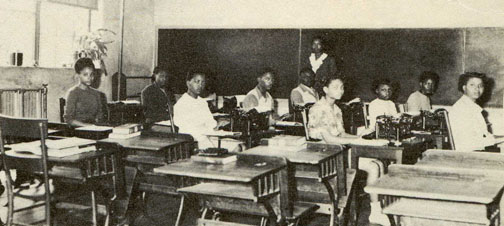
|
|
|
|
|
|
|
|
|
|
|
|
|
|
|
|
|
|
|
|
|
|
|
|
|
|
|
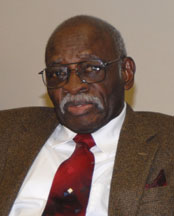 Frank Crump, Jr.
Frank Crump, Jr. |
“We were taught Negro history and were taught about black leaders who were involved in the struggle for civil rights. The accomplishments by blacks were featured and highlighted in our curriculum.” Frank Crump, Jr.
|
|
|
|
|
|
|
|
|
|
|
|
|
|
|
|
|
|
|
|
|
|
|
|
|
|
|
|
|
|
|
|
|
|
|
|
from Secondary School Study documents:
Evaluation Programs: Collecting and Using Information concerning
School Growth, Teacher Growth and Pupil Growth
"The matter of drawing up different kinds of reports has always constituted a heavy responsibility for all schools. For a long time these reports were made largely to and for agencies other than the school itself. Hence, not many of the reports were planned by the teachers and schools made little use of the reports. In fact, the data used in developing the reports as well as the reports themselves could seldom be found in the schools after the report was submitted to the persons requesting it. The responsibility was usually discharged as a matter of duty rather than as a part of the planning within the school for its growth and development.
Recent efforts on the part of classroom teachers to promote definite kinds of growth among their pupils revealed a need for more adequate and more complete information concerning the progress being made toward the goals which were set up.
The experience and insight which teachers gained as they collected, organized and interpreted information on the growth of the program of the school lead many teachers to believe that pupils, too, might profit by participating in similar activities. The teachers gradually discovered the provided opportunities for pupils to participate in collecting, organizing and interpreting information concerning some phases of their own growth.

Magnolia teachers, l-r: Ms. Richardson, Ms. C. M. Allen,
Mrs. Jackson, Ms. B. Crawford
At present there is a nation-wide effort to discover practical and economical ways by which progress toward educational goals may be followed. This definite trend is to be expected since teachers could hardly engage in planning for school development without discovering the value of reflective thinking in the process. The experience of passing judgment on the worthwhileness of educational programs which the teachers themselves plan seems to sensitize teachers to the need for adequate facts on which they can base judgments."
from the Secondary School Study Catalog, circa 1940 |
|
|
|
|
|
|
|
|
|
|
|
|
|
|
|
|
|
|
|
|
|
|
|
|
|
|
|
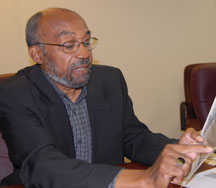
Edgar E. Smith |
|
“The interaction between student and teacher was so important. Teachers did not just lecture; they pushed us to interact with them and to come to understand the knowledge. Recitation was still important, however; I recall reciting Milton sonnets. But what was most important was the interaction between the student, the teacher, and the content.”
Edgar E. Smith |
|
|
|
|
from Secondary School Study documents:
K. E. Smith, Magnolia Debating Team and science teacher
"In the summer of 1941, Miss K. E. Smith, attended the workshop at Hampton Institute. Even before this time, there was much cooperative planning of work in her classes, and many learning situations were set up which were designed to connect the general science studies with the experiences of the children. This tendency on the part of the teacher was accelerated by the help she received at Hampton, and this year she has been experimenting a good deal with unit teaching.”
from A Report of Teacher-Pupil Activities, 1942 |
|
|
|
|
|
|
|
|
|
|
|
|
|
|
|
|
|
|
|
|
|
|
|
|
|
|
|

return to Magnolia
|
|
|
|
|
|
|
|
|
|
|
|
|
|
|
|
|
|
|
|
|
|
|












